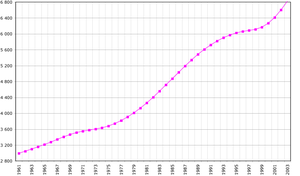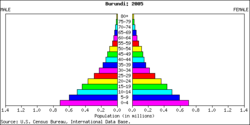- Demographics of Burundi
-
This article is about the demographic features of the population of Burundi, including population density, ethnicity, education level, health of the populace, economic status, religious affiliations and other aspects of the population.
At 206.1 persons per km²., Burundi has the second-largest population density in Sub-Saharan Africa. Most people live on farms near areas of fertile volcanic soil. The population is made up of three major ethnic groups – Hutu (Bahutu), Tutsi (Batutsi or Watusi), and Twa (Batwa). Kirundi is the common language. Intermarriage takes place frequently between the Hutus and Tutsis. The terms "pastoralist" and "agriculturist", often used as ethnic designations for Watusi and Bahutu, respectively, are only occupational titles which vary among individuals and groups. Although Hutus encompass the majority of the population, historically Tutsis have been politically and economically dominant.
CIA World Factbook demographic statistics
The following demographic statistics are from the CIA World Factbook, unless otherwise indicated.
Population
- 10,216,190
- Note: estimates for this country explicitly take into account the effects of excess mortality due to AIDS; this can result in lower life expectancy, higher infant mortality and death rates, lower population and growth rates, and changes in the distribution of population by age and sex than would otherwise be expected (July 2011 est.)
Age structure
- 0-14 years: 46.3% (male 1,884,825/female 1,863,200)
- 15-64 years: 51.1% (male 2,051,451/female 2,082,017)
- 65 years and over: 2.6% (male 83,432/female 125,143) (2006 est.)
Median age
- Total: 16.7 years
- Male: 16.5 years
- Female: 17.0 years (2009 est.)
Population Growth Rate
- 3.462% (2011 est.)
Birth rate
- 41.01 births/1,000 population (2011 est.)
Death rate
- 9.61 deaths/1,000 population (2011 est.)
Net migration rate
- 4.04 immigrant(s)/1,000 population (2009 est.)
Urbanization
- Urban population: 10% of total population (2009 est.)
- Rate of urbanization: 6.8% annual rate of change (2005-10 est.)
Sex ratio
- At birth: 1.03 male(s)/female
- Under 15 years: 1.01 male(s)/female
- 15-64 years: 0.99 male(s)/female
- 65 years and over: 0.68 male(s)/female
- Total population: 0.99 male(s)/female (2009 est.)
Infant mortality rate
- Total: 59.64 deaths/1,000 live births
- Male: 66.32 deaths/1,000 live births
- Female: 55.76 deaths/1,000 live births (2009 est.)
Life expectancy at birth
- Total population: 52.09 years
- Male: 51.2 years
- Female: 53.01 years (2009 est.)
Total fertility rate
- 6.33 children born/woman (2009 est.)
- 6.25 children born/woman (2010 est.)
HIV/AIDS
- Adult prevalence rate: 2% (2007 est.)
- People living with HIV/AIDS: 110,000 (2007 est.)
- Deaths: 11,000 (2007 est.)
Major infectious diseases
- Degree of risk: very high
- Food or waterborne diseases: bacterial diarrhea, hepatitis A, and typhoid fever
- Vectorborne disease: malaria
- Water contact disease: schistosomiasis
- Animal contact disease: rabies (2009)
Nationality
- Noun: Burundian(s)
- Adjective: Burundian
Ethnic groups
- Hutu (Bantu) 85%, Tutsi 14%, Twa (Pygmy) 1%, Europeans 7,000, South Asians 2,000
Religions
Main article: Religion in Burundi- Christian 75% (Roman Catholic 60%, Protestant 15%), indigenous beliefs 20%, Muslim 5%
Languages
- Rundi (official), French (official), Swahili (along Lake Tanganyika and in the Bujumbura area)
Literacy
- Definition: age 15 and over can read and write
- Total population: 59.3%
- Male: 67.3%
- Female: 52.2% (2003 est.)
Education expenditure
- 5.1% of GDP (2005)
References
 This article incorporates public domain material from the CIA World Factbook document "2008 edition".
This article incorporates public domain material from the CIA World Factbook document "2008 edition".Demographics of Africa Sovereign
states- Algeria
- Angola
- Benin
- Botswana
- Burkina Faso
- Burundi
- Cameroon
- Cape Verde
- Central African Republic
- Chad
- Comoros
- Democratic Republic of the Congo
- Republic of the Congo
- Côte d'Ivoire (Ivory Coast)
- Djibouti
- Egypt
- Equatorial Guinea
- Eritrea
- Ethiopia
- Gabon
- The Gambia
- Ghana
- Guinea
- Guinea-Bissau
- Kenya
- Lesotho
- Liberia
- Libya
- Madagascar
- Malawi
- Mali
- Mauritania
- Mauritius
- Morocco
- Mozambique
- Namibia
- Niger
- Nigeria
- Rwanda
- São Tomé and Príncipe
- Senegal
- Seychelles
- Sierra Leone
- Somalia
- South Africa
- South Sudan
- Sudan
- Swaziland
- Tanzania
- Togo
- Tunisia
- Uganda
- Zambia
- Zimbabwe
States with limited
recognition- Sahrawi Arab Democratic Republic
- Somaliland
Dependencies and
other territories- Canary Islands / Ceuta / Melilla / Plazas de soberanía (Spain)
- Madeira (Portugal)
- Mayotte / Réunion (France)
- Saint Helena / Ascension Island / Tristan da Cunha (United Kingdom)
- Western Sahara
 Burundi topics
Burundi topicsHistory Timeline · Burundi Civil War · Colonial heads · Genocide · German East Africa · Ruanda-Urundi · Monarchy · Second Congo WarPolitics Elections · Flag · Foreign relations · Human rights · Law enforcement · Military · Ministers · National Assembly · Political parties · Provincial governors · President · Prime Minister · SenateGeography Economy and infrastructure Culture and society List of Burundi-related topics Categories:- Burundian society
- Demographics by country
Wikimedia Foundation. 2010.


